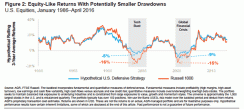To view a PDF of the full report, click here.
July 20161
Introduction
Over a 40-year working life, defined contribution (DC) plan savers try to maximize two basic investment outcomes: wealth accumulation and wealth preservation. However, these objectives present a basic tradeoff: for many retirement savers, the investments designed to promote wealth accumulation (equities) are different from the investments designed to promote wealth preservation (e.g., cash, bonds). Defensive equities seek to provide a “best of both worlds”: delivering the equity risk premium to achieve wealth accumulation, but by investing in less-risky equity securities to promote wealth preservation.
The Defensive Premium
One of the oldest findings in finance is that lower-risk stocks deliver returns that are “too high” compared to what traditional models predict.2 As shown in Figure 1, over the long term, lower-risk U.S. stocks (left side) have delivered approximately the same average return as higher-risk stocks (right side). Defensive equity3 strategies seek to capture this premium by investing across a range of low-risk stocks, with the objective of achieving market-like returns but with less volatility.4
What Drives the Defensive Premium?
Various theories seek to explain why defensive stocks perform as well as they do. One of the oldest and most tested is “leverage aversion,” which considers what happens to stock prices when a meaningful subset of investors are unable or unwilling to use leverage.
In general, equity investors with aggressive return targets have two options: 1) invest in higher-risk stocks in hopes of being rewarded with commensurately higher returns, or 2) use leverage to magnify the return on lower-risk stocks. However, in a leverage-averse world, investors do not have a choice between options 1 and 2. Instead, they are forced to take option 1: invest in higher-risk stocks.
The resulting high demand for higher- risk stocks means their prices get bid up and their expected returns go down. The opposite holds for lower-risk, or defensive, stocks: Because there is less demand for them, their prices are bid lower and thus may be expected to perform better than they otherwise would.
What Makes a Stock “Defensive”?
There are many ways to evaluate whether a security is defensive. These fall into two categories: fundamental and quantitative. From a fundamental perspective, companies with low risk may have relatively high margins, sustainable earnings and low credit risk.5 From a quantitative standpoint, companies with low risk may be those with low beta, or sensitivity to the market, or low volatility. We believe both categories are useful for identifying defensive companies and that the combination is likely to produce a more robust portfolio of truly defensive stocks.
Defensive and Defined Contribution
Defensive equities may be among the best suited to meet the twin objectives of wealth accumulation and wealth preservation. Figure 2 charts the rolling threeyear average returns of two portfolios: a hypothetical U.S. large-cap defensive equity strategy and the Russell 1000. In good times the returns are comparable,which supports the idea that defensive equities may achieve returns on par with passive equities and thus provide a similar engine for growth.
The difference, though, can be seen in the shaded areas in Figure 2 — periods when lower volatility led to smaller drawdowns, demonstrating that defensive equities may be better at achieving wealth preservation in down markets.6 This characteristic is clearly valuable near retirement, when investors have less time to ride through a market drawdown. But it may also aid younger savers, who may be less likely to throw in the towel after a severe — and potentially prolonged — bear market, maintaining the allocations they need to accumulate enough savings for retirement.

2 Early studies include Black (1972).
3 Defensive Equity, Low Beta, Minimum Variance, Low Volatility — these names all describe investment strategies that generally seek to overweight safe securities and underweight risky securities (relative to capitalizationweighted benchmarks).
4 Evidence for the defensive premium is pervasive. Beyond the U.S., we find decades of evidence in international markets and in other asset classes—such as bonds and credit—that point to the same basic conclusion: Defensive strategies may generate returns similar to those of overall markets but with less volatility (and thus generally smaller drawdowns).
5 Consistent with the earlier evidence, safe, profitable and stable companies have historically earned higher riskadjusted returns than risky, unprofitable and unstable firms, as shown in Piotroski (2002), Novy-Marx (2012), Asness, Frazzini and Pedersen (2012).
6 Over the full period show in Figure 2, the average volatility and total return of the Russell 1000 are 15% and 11%, respectively. For the Hypothetical Defensive Strategy the average volatility and total return are 12% and 12%, respectively.
Bibliography
Asness, A., Frazzini, A., Pedersen, L.H. (2012), “Quality Minus Junk,” Working Paper.
Black, F. (1972), “Capital Market Equilibrium with Restricted Borrowing,” The Journal of Business, Vol. 45, No. 3, pp. 444-455.
Frazzini, A., Friedman, J., Kim, H. (2012), “Understanding Defensive Equity,” AQR White Paper.
Novy-Marx, Robert (2013), “The Other Side of Value: The Gross Profitability Premium,” Journal of Financial Economics 108(1), 2013, 1-28. Piotroski, Joseph D. (2000), “Value Investing: The Use of Historical Financial Statement Information to Separate Winners from Losers,” Journal of Accounting Research, 38, 1-41.

that employs a systematic, research-driven
approach to manage alternative and traditional
strategies. As of June 30, 2016, we managed
approximately $159 billion for institutional
investors and investment professionals.
Disclosures
This material has been provided to you solely for information purposes and does not constitute an offer or solicitation of an offer or any advice or recommendation to purchase any securities or other financial instruments and may not be construed as such. The factual information set forth herein has been obtained or derived from sources believed by the author and AQR Capital Management, LLC (“AQR”) to be reliable but it is not necessarily all-inclusive and is not guaranteed as to its accuracy and is not to be regarded as a representation or warranty, express or implied, as to the information’s accuracy or completeness, nor should the attached information serve as the basis of any investment decision. The information set forth herein has been provided to you as secondary information and should not be the primary source for any investment or allocation decision.
Past performance is not a guarantee of future performance.
Diversification does not eliminate the risk of experiencing investment loss.
Broad-based securities indices are unmanaged and are not subject to fees and expenses typically associated with managed accounts or investment funds. Investments cannot be made directly in an index. The Russell 1000 Index is a stock market index that represents the highest-ranking 1,000 stocks in the Russell 3000 Index, which represents about 90% of the total market capitalization of that index.
This document is not research and should not be treated as research. This document does not represent valuation judgments with respect to any financial instrument, issuer, security or sector that may be described or referenced herein and does not represent a formal or official view of AQR.
The views expressed reflect the current views as of the date hereof and neither the author nor AQR undertakes to advise you of any changes in the views expressed herein. It should not be assumed that the author or AQR will make investment recommendations in the future that are consistent with the views expressed herein, or use any or all of the techniques or methods of analysis described herein in managing client accounts. The information contained herein is only current as of the date indicated and may be superseded by subsequent market events or for other reasons. Charts and graphs provided herein are for illustrative purposes only. Nothing contained herein constitutes investment, legal, tax or other advice nor is it to be relied on in making an investment or other decision.
There can be no assurance that an investment strategy will be successful. Historic market trends are not reliable indicators of actual future market behavior or future performance of any particular investment which may differ materially and should not be relied upon as such.
The investment strategy and themes discussed herein may be unsuitable for investors depending on their specific investment objectives and financial situation. Hypothetical performance results (e.g., quantitative backtests) have many inherent limitations, some of which, but not all, are described herein. No representation is being made that any fund or account will or is likely to achieve profits or losses similar to those shown herein. In fact, there are frequently sharp differences between hypothetical performance results and the actual results subsequently realized by any particular trading program. One of the limitations of hypothetical performance results is that they are generally prepared with the benefit of hindsight. In addition, hypothetical trading does not involve financial risk and no hypothetical trading record can completely account for the impact of financial risk in actual trading. For example, the ability to withstand losses or adhere to a particular trading program in spite of trading losses are material points which can adversely affect actual trading results. The hypothetical performance results contained herein represent the application of the quantitative models as currently in effect on the date first written above and there can be no assurance that the models will remain the same in the future or that an application of the current models in the future will produce similar results because the relevant market and economic conditions that prevailed during the hypothetical performance period will not necessarily recur. There are numerous other factors related to the markets in general or to the implementation of any specific trading program which cannot be fully accounted for in the preparation of hypothetical performance results, all of which can adversely affect actual trading results. Discounting factors may be applied to reduce suspected anomalies. This backtest’s return, for this period, may vary depending on the date it is run. Hypothetical performance results are presented for illustrative purposes only. In addition, our transaction cost assumptions utilized in backtests, where noted, are based on AQR’s historical realized transaction costs and market data. Certain of the assumptions have been made for modeling purposes and are unlikely to be realized. No representation or warranty is made as to the reasonableness of the assumptions made or that all assumptions used in achieving the returns have been stated or fully considered. Changes in the assumptions may have a material impact on the hypothetical returns presented.





